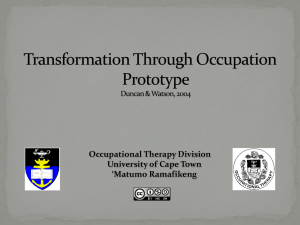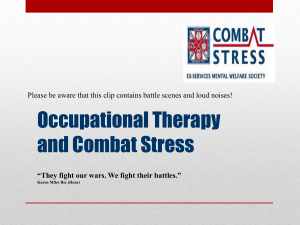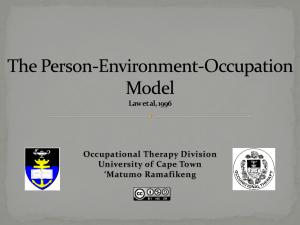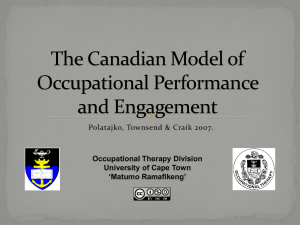Transformation Through Occupation - Vula
advertisement
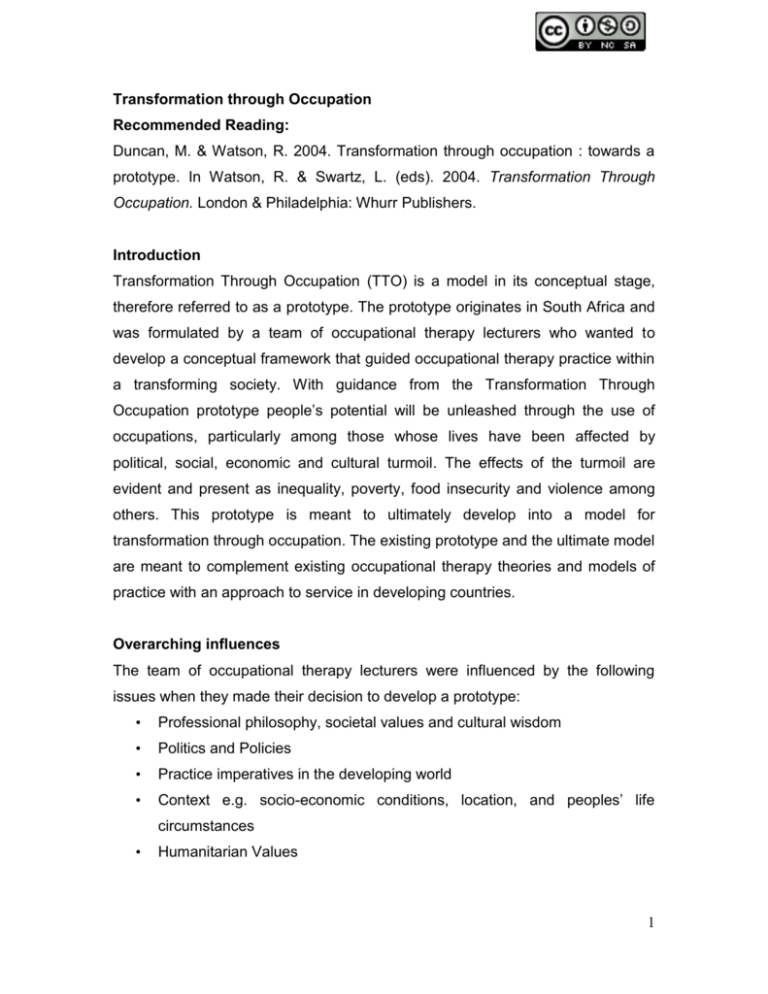
Transformation through Occupation Recommended Reading: Duncan, M. & Watson, R. 2004. Transformation through occupation : towards a prototype. In Watson, R. & Swartz, L. (eds). 2004. Transformation Through Occupation. London & Philadelphia: Whurr Publishers. Introduction Transformation Through Occupation (TTO) is a model in its conceptual stage, therefore referred to as a prototype. The prototype originates in South Africa and was formulated by a team of occupational therapy lecturers who wanted to develop a conceptual framework that guided occupational therapy practice within a transforming society. With guidance from the Transformation Through Occupation prototype people’s potential will be unleashed through the use of occupations, particularly among those whose lives have been affected by political, social, economic and cultural turmoil. The effects of the turmoil are evident and present as inequality, poverty, food insecurity and violence among others. This prototype is meant to ultimately develop into a model for transformation through occupation. The existing prototype and the ultimate model are meant to complement existing occupational therapy theories and models of practice with an approach to service in developing countries. Overarching influences The team of occupational therapy lecturers were influenced by the following issues when they made their decision to develop a prototype: • Professional philosophy, societal values and cultural wisdom • Politics and Policies • Practice imperatives in the developing world • Context e.g. socio-economic conditions, location, and peoples’ life circumstances • Humanitarian Values 1 These issues have to be kept in mind when putting the prototype into practice, because they are at the heart of occupational performance dynamics as enablers or inhibitors for societies of developing countries. The purpose of the Transformation Through Occupation prototype is to: Promote occupation as a vehicle to achieve health and well-being Unleash human potential, by meeting occupational needs. Facilitate occupational empowerment and engagement. Generate evidence of practice appropriate to context. Extend the focus of occupational and community development from individual to group and population. Fundamental concepts The prototype is based on the following founding concepts: Development- a moral-based initiative that is aimed at utilizing processes, plans and policies to empower vulnerable individuals, groups and communities to meet their own basic needs through the engagement in occupations. Through development, attention is paid to public health and sectoral issues and the acquisition of resourcefulness. Human Rights enforcement especially economic, social and cultural rights) and development are vital for the realization of transformation. Human Rights relate to matters of social and occupational justice that impact on occupation. Transformation- entails an agreed upon two-way process within which the client and the occupational therapist are influenced and changed by the same process. Transformation is based on the ideology of human rights and a belief that personal power can come through collective problem solving and action. On the other hand, transformation is also based on the belief that collective power is strengthened through individual social action. Transformation- a continuous process of changing towards a desired form, character, appearance or substance. This process is 2 precipitated by critical inquiry, promoted by praxis and motivated by the desire for personal growth and eventual social change. Core components of the prototype The following components of the prototype are presented as a jigsaw puzzle to depict interdependence and mutual support: The client can be an individual, a community, population or a group at risk of ill health. Environment is expected to be inclusive and empowering in order to enable transformation through occupation. However, in the context of developing countries contextual/environmental barriers such as poverty, alienation compromise freedom of choice. Therefore, occupational injustice and the negative effects of poor occupational choices are evident. Occupation (s) are to be the tool for transformation, therefore they have to be appropriate to the client, affordable and available or easily accessible. Occupational therapist acts as the enabler of change, the advisor and guide. In the process of transformation, both the client and the therapist experience personal growth. The four components of the Transformation Through Occupation prototype relate to one another in a dynamic and transactional manner that is inseparable from temporal and metaphysical factors or phenomenon that is physical, psychological or socio-cultural. Prerequisites for transformation For transformation to be effected, dimensions of critical inquiry, praxis and personal growth and social change are needed between the client and the therapist as role players. Transformation is precipitated by critical inquiry, promoted by praxis and motivated by the desire to grow on a personal level. 1. Critical inquiry refers to reflective reconstruction of experiences and giving and receiving feedback through sharing. Critical thinking 3 acknowledges the unique experiences of each individual and allows for everyone to be a contributor of experience in development. Critical inquiry could be achieved through building a collaborative framework and transcending known ways of thinking and acting. 2. Praxis is defined as committed informed goal directed action. Principles of praxis include optimism about development and the scope for change as well as reflexivity- an action research and learning approach. 3. Personal growth entails building trust, therefore enabling participation, learning and challenging of assumptions The Occupational Therapy Process This process can be described as: A liberating process that is characterized by a cycle of reflection and participatory action within and on the world. A process that instills hope and promotes a sense of belonging and purpose. This process counteracts problems of powerlessness through securing sharing of perspectives and creating opportunities for bonding. The occupational therapists contribution to the cycle of reflection and participatory action is to impel to act through active engagement in occupation (s) and this would enable development of capacity. The aim of the Occupational Therapy Process The aim of the process is to enable client to understand ideologies of oppression within themselves and in their social environments, so that they could transform their environments into ones that enable them to meet their basic needs and expectations. Methods of facilitating occupation Facilitating occupation both as a means and as an end could be done through: Awareness raising- making known things that are problematic. 4 Activism- seeking liberating alternatives to problems and identifying critical actions to facilitate change. Advocacy- being the voice of the oppressed and vulnerable in solidarity. Educating- providing information and liberating people through knowledge about access to resources for growth. Training- equipping people with skills that enable them to take action to meet their basic needs. Experiential learning- creating opportunities for learning through trying out, modeling and receiving and giving feedback. Reference: Duncan, M. & Watson, R. 2004. Transformation through occupation: towards a prototype. In Watson, R. & Swartz, L. (eds). 2004. Transformation Through Occupation. London & Philadelphia: Whurr Publishers. Personal communication with Staff and students: Division of Occupational Therapy, University of Cape Town. Conceptual Frameworks by Matumo Ramafikeng, Health Sciences UCT, 2010 Licensed under a Creative Commons Attribution-Noncommercial-Share Alike 2.5 South Africa License. 5
